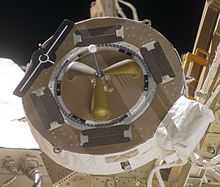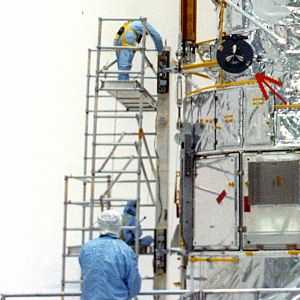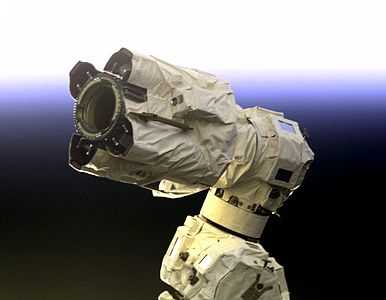Grapple Fixture
Grapple Fixtures are used on capsules, satellites and other objects to provide a secure connection for robotic arms. The fixtures allow arms aboard the former Space Shuttle or Canadarm2 and the Japanese Remote Manipulator System aboard the International Space Station to safely grapple large objects.[1] Grapple fixtures are flat in appearance, with a central grapple pin topped with a sphere which the snares in the end of the arms latch on to. They use three "ramps" that help lock the robotic arm correctly onto grapple fixture.[2]
Development
The Grapple Fixture was developed at Spar Aerospace in the 1970s. Its invention is credited to Frank Mee, who also invented the Canadarm end effector for the Space Shuttle.[3] The Grapple Fixture design was further refined by Barrie Teb.[3]
Variants
Power Data Grapple Fixture

A Power Data Grapple Fixture (PDGF) is a quick connect fixture used on the International Space Station (ISS). PDGFs can be "grappled" by the Canadarm2 robotic arm, in order to allow the arm to manipulate and power a grappled object, or be commanded by operators based inside the ISS. PDGFs located around much of the station provide connections for the arm. They all have four rectangular connectors to transfer data, video and electrical power. Delivered by Space Shuttle Atlantis there are four PDGFs on the American made Mobile Transporter (MT) that travels 108 metres along truss mounted rails.[4] During STS-134 a PDGF was installed on the Zarya module to support Canadarm2 operations based from the Russian segment.[5]
Flight-Releasable Grapple Fixture

A Flight-Releasable Grapple Fixture (FRGF) is a passive fixture which is identical to the Power Data Grapple Fixture (PDGF) but lacks its power and data ports. Unpiloted ships like the SpaceX Dragon, Cygnus (spacecraft) and Japanese (HTF) or H-II Transfer Vehicle include a standard FRGF which is used by the Canadarm2 to grapple the capsule on approach to the International Space Station for berthing.[6] The fixture can have a maximum payload rating 0f 65,000 pounds or 143,000 kg.[7]
Canadarm2
The 1,641 kg, 17 metre long, three jointed, robotic arm is self-relocating and can move end-over-end on the PDGFs to reach many parts of the Space Station in an inchworm-like movement.[8] In this movement, it is limited only by the number of Power Data Grapple Fixtures (PDGFs) on the station. Power and data are supplied to Canadarm2 from the ISS, and to a grappled payload from Canadarm2.[9] There is one PDGF on Dextre, which has smaller arms and tools for Canadarm2.
Remote Manipulator System
The Remote Manipulator System (JEMRMS) is a 10m long robotic arm, secured to the port cone of the Japanese "Permanent Module", it is intended to service the "Exposed Facility" and to move equipment to and from the "Experiment Logistics Module". The arm can use two types of ISS-common grapple fixtures: the Flight Releasable Grapple Fixture (FRGF) and the Power and Video Grapple Fixture (PVGF). The "Small Fine Arm", is 2m long and has a grapple fixture to attach to the end effector of the main arm.
-

End effector on the Shuttle CanadArm uses 3 cables to snare a grapple fixture
-

Grapple fixture on the Hubble Space Telescope(red arrow pointing at dark circle). This allowed Hubble to be moved with the Space Shuttle CanadArm
-

International Space Station - one of the Canadarm2 End effectors surrounded by four latch mechanisms
References
- ↑ http://iss.jaxa.jp/en/htv/mission/htv-1/presskit/htv-1_presskit.pdf pg19
- ↑ CanadaArm2 End Effector
- ↑ 3.0 3.1 Dotto, Lydia (1992). A Heritage of Excellence: 25 years at Spar Aerospace Limited. David Steel. Canada: Spar Aerospace Limited. pp. 42–43. ISBN 0-9696618-0-0.
- ↑ http://www.asc-csa.gc.ca/eng/iss/mobile-base/default.asp
- ↑ http://www.nasa.gov/pdf/538352main_sts134_presskit_508.pdf
- ↑ Space station catches Dragon by the tail
- ↑ "Progress in Astronautics and Aeronautics V.161: Teleoperation and Robotics in Space". American Institute of Aeronautics and Astronautics. 1994. p. 460. Retrieved 30 January 2015.
- ↑ http://www.asc-csa.gc.ca/eng/iss/canadarm2/nuts_bolts.asp
- ↑ Mobile Servicing System